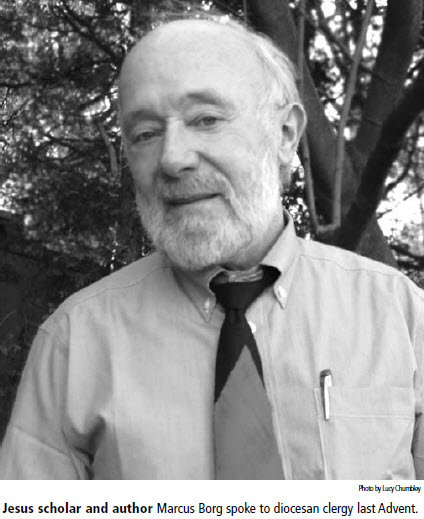[Washington Window] The Christmas story is probably the best known narrative on earth.
For the world’s 2 billion Christians these are “the stories of our tribe,” author and theologian Marcus Borg told a group of diocesan clergy last Advent. “It would be hard to think of another set of stories that is as well known.”
The nativity tableau has appeared in countless forms, from icons to greetings cards, he said. It has been re-enacted in churches of every denomination and has entered the cultural consciousness to such an extent that even non-Christians are familiar with the story.
But many have understood these stories as if they were intended to record “the way it really happened,” he said. “It is only in the last 50 years that a lot of Christians have aggressively questioned that.”
As a child, he said, “I believed things really did happen this way, that there really was a magic star. I don’t think it took faith to believe this. I heard these stories as a child in a state of pre-critical naiveté – when you effortlessly take for granted what your community tells you. When you become an adult in contemporary culture, it becomes effortful to believe. You either believe or you don’t. They’re either factually true or they’re not at all.”
And that’s the trouble: Many mainline Christians think there are just two options, he said: fact or fable. “Many are understandably skeptical about these things.”
The star of the nativity story moves “with the precision of a GPS,” he said. And the search for a natural explanation “completely misses the fact that this star is no natural phenomenon whatsoever. These stories were not even intended by their authors as factual reports,” he added, but rather were designed to be heard, seen and interpreted as parables and overtures.
The two accounts of the nativity, in the Gospels of Matthew and Luke, are quite different, Borg said. But there are certain commonalities. Both state that Jesus was conceived by the Holy Spirit, born to Joseph and Mary in Bethlehem near the end of the rule of Herod, and grew up in Nazareth. And both accounts were written well after the events described.
But after this the stories start to diverge. (“It would be very interesting for a church to do two Christmas pageants; one based only on Matthew and one based only on Luke,” Borg said.)
The account in Matthew is much briefer, Borg said. Joseph marries Mary despite her pregnancy; they live in Bethlehem and Jesus is born at home. Wise men see a star and follow it to Herod’s court in Bethlehem. Herod kills the children under the age of 2, Mary and Joseph flee to Egypt. They plan to return to Bethlehem after Herod dies but Joseph has a warning in a dream and they return to Nazareth instead.
Joseph is the main character in this narrative – Mary does not say a word. Revelations come to Joseph in the form of dreams – five of them (echoes of Moses).
“The tone of Matthew’s story is very dark,” Borg said. “It’s really dominated by Herod’s plot to kill Jesus. There’s no joy in Matthew’s story.” One of Matthew’s central themes is “Jesus as a new Moses,” and includes elements like dreams and fulfillment of prophesy.
The account in Luke is four times longer, and includes genealogy that goes back to Adam (while Matthew’s goes back to Abraham). It begins with the conception of John to Zechariah and Elizabeth (echoes of Abraham and Sarah). Gabriel tells Mary (in Nazareth) that she will conceive by the Holy Spirit and give birth. Mary visits Elizabeth and sings the Magnificat. John is born and Zechariah sings the Benedictus. Mary and Joseph travel to Bethlehem to take part in the census, and Jesus is born in a stable. Angels appear to shepherds. Mary visits the Temple, Simeon sings the Nunc Dimitis. Jesus returns to the Temple at age 12.
The main character in this narrative is Mary, and Elizabeth and Zechariah, Simeon and Anna play important parts. “The tone is very different – full of hope, rejoicing and celebratory hymns.”
Luke’s main theme is the “spirit of God,” and the emphasis is on women and the downtrodden.
Given the great differences in the two Gospel accounts, Borg said, “how should we see, hear, preach and teach these stories?”
Borg believes the nativity stories should be seen as metaphorical narratives.
Nowadays, “metaphor is often seen as less than factual… as if the symbolic meaning is somehow less than the factual,” he said. “Pretty much every story in the Bible is there because it has a more than factual meaning, and this is why our ancestors told these stories. These stories are parabolic overtures to the Gospels.
“In general, parables are about meaning. The meaning and truth of a parable is not dependent on its factuality. … it doesn’t matter if there really was a Good Samaritan, a Prodigal Son – and to get into an argument about whether there was would be to miss the point. The point of parables is their meaning.
Parables can be truth filled – truthful – whether they happened or not. Jesus told parables about God; his followers told parables about him. In short, the birth stories are about meaning. Believe whatever you want about them – now let’s talk about what they mean.”
Just as an overture to a symphony or opera sounds the central themes of a longer work that follows, “Matthew and Luke wrote their overtures after they knew what was in the rest of their Gospels,” Borg said. “These are not Christmas pageants for children. They are the Gospels in miniature.”
Borg explores the Gospel themes in depth in a book he co-authored with fellow Jesus scholar John Dominic Crossan: The First Christmas: What the Gospels Really Teach About Jesus’s Birth (HarperCollins, 2007). Visit Borg’s website to learn more.

